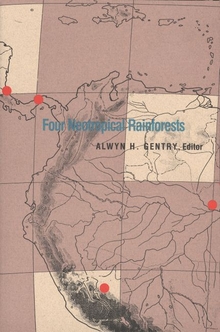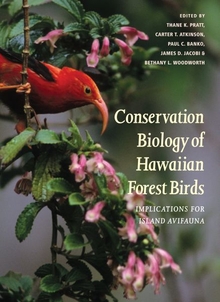Four Neotropical Rainforests
WARNING
You are viewing an older version of the Yalebooks website. Please visit out new website with more updated information and a better user experience: https://www.yalebooks.com
Edited by Alwyn H. Gentry
The rapid disappearance of tropical forests is widely recognized as a crucial problem for the world's environment, yet little is known about these complex ecosytems. In this book, experts on the four most thoroughly studied rainforests in Central and South America—Manaus, Brazil; Manu Park, Peru; Barro Colorado Island, Panama; and La Selva, Costa Rica—compare the flora, fauna, and ecological characteristics of these forests. This assemblage of reliable data, available for the first time, will be an invaluable resource for researchers and students.
"An excellent contribution to our understanding of Neotropical rainforests. The book will be of value not only to tropical biologists but to a spectrum of community ecologists, ornithologists, mammalogists, botanists, geographers, and conservation biologists."—Philip W. Rundel, University of California, Los Angeles
"Summarizes intensive research carried out in the vicinity of permanent field stations. . . . [An] exemplar of the essential ingredient of tropical forest research: long-term effort. . . . Naturally, neotropical forest biologists will find a lot of familiar as well as new information in here, but they should recognize that the book is a landmark and should read it. The key lies in the way the information has been drawn together and presented, such that it provides some very clear signposts to the issues that remain to be tackled. Also, the introductory and overview chapters, in particular, are worth the attention of non-neotropical biologists wishing either to enter the field or simply to keep up with neotropical forest research."—Andrew M. Sugden, TREE (Trends in Ecology and Evolution)
"This book represents a milestone in our knowledge about the structure and function of New World tropical forests. Though it contains an impressive amount of information about what we do know about certain aspects of these forests, it is perhaps more valuable for highlighting what we do not know about them."—Theodore H. Fleming, Science
"Surely destined to be a classic of tropical forest science. . . . The book is something of a tour de force. . . . It should find a place on the bookshelves of all who concern themselves with tropical forests as the most remarkable expression of nature to grace the surface of the planet in four billion years of life's history. Emphatically recommended."—Norman Myers, BioScience
"The book . . . should be of interest to all biologists who study tropical forests or organisms that occur in them. Those with an interest in tropical birds that breed in temperate forests during our relatively brief warm season may want to read about resident tropical avifaunas within which these migrants spend most of the year."—Paul A. Opler, Wildlife Review
"Recommended for professional conservation biologists, ecologists, ornithologists, mammalogists, botanists, and geographers."—Wildlife Activist
"The text is well written, there are a scientific and a subject index, and the book has been attractively produced. Those interested in the biology of natural forest conditions in the Neotropics would enjoy the overview of activities."—D. Burger, Forestry Chronicle
"Tropical rainforests are a subject of much current attention, yet comparatively little is known about them. This book contains the proceedings of a symposium organized by the Association for Tropical Biology, aimed at comparing the faunas, floras, and forest dynamics of the four most extensively studied sites in the neotropics: La Selva in Costa Rica; Barro Colorado Island, Panama; Cocha Cashu in the Manu National Park, Peru; and the Minimum Critical Size of Ecosystems study area near Manaus in Brazil. The first section describes the study sites themselves. Subsequent sections cover floristics, birds, mammals, reptiles and amphibians, and forest dynamics. Within each section the papers concerning the individual sites are followed by an overview comparing the ecosystems. . . . The book contains a tremendous wealth of information and references, and will be of great value to anyone visiting or working in the neotropics. In this respect the comprehensive scientific and subject indices are a useful addition."—Pete Cotton,
IBIS
"Provides a much-needed window on the world of tropical forest research and the progress we are making in cataloging the richness of this realm. . . . From a reading of this book, it is safe to say that the bird faunas are the best known of any of the biotic components of the four ecosystems. . . . These [five] bird chapters exhibit the diversity of field method and approach employed during the last two decades. . . . A very important contribution to the study of Neotropical humid forests. All fieldworkers who focus on rainforest biotas should have the book, as should all university libraries."—Bruce M. Beehler, The Auk
"Gentry expertly has taken on the essential task of compiling a tremendous mass of data and theories being generated by prominent ecologists in the neotropics into a comparative body of work. . . . The task is done magnificently. The scope of the book is enormous and the detail fine."—Jan Salick, Ecology
"Valuable and reliable data about the ecological characteristics, flora, and fauna of these forests are presented in this volume by the experts. . . . A signal contribution to the discussion of the rainforest problem that is of fundamental importance to global ecology, climate, and the life on this planet."—A. S. Walton, International Journal of Environmental Studies
"I recommend this book to anyone seriously interested in Neotropical ecology."—John C. Kricher, Wilson Bulletin
"An important book. . . . It is a milestone summarizing our understanding of tropical ecosystems."—John G. Robinson, Journal of Wildlife Management
"Gentry . . . has done a superb editorial job of collecting and editing this enormous collection of biological and ecological data and theories pertaining to neotropical forests. . . . The book will serve as an excellent introduction for beginners and a valuable reference for advanced students of tropical ecology."—Eduardo E. Iñigo-Elias, Journal of Field Ornithology
ISBN: 9780300054484
Publication Date: January 27, 1993
Publication Date: January 27, 1993
640 pages, 6 1/8 x 9 1/4








